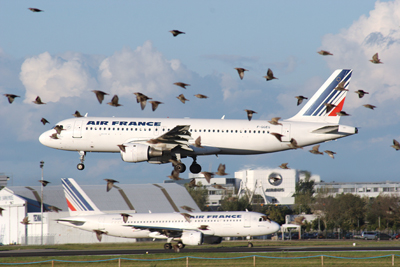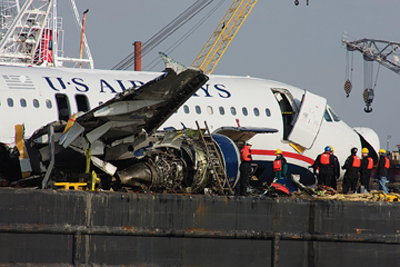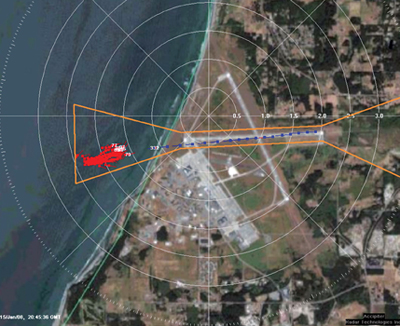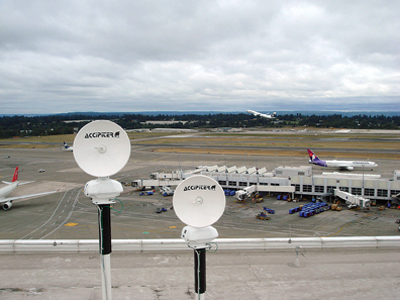
Features
Air Traffic
Striking Back With Avian Radar
More than a century after the first recorded bird strike – involving aero pioneer Orville Wright and birds he was chasing while flying near Dayton, Ohio – US Airways Flight 1549 collided with a flock of Canada geese at approximately 3,100 feet over New York City on Jan. 15, 2009.
November 30, 2009 By Blair Watson
More than a century after the first recorded bird strike – involving aero pioneer Orville Wright and birds he was chasing while flying near Dayton, Ohio – US Airways Flight 1549 collided with a flock of Canada geese at approximately 3,100 feet over New York City on Jan. 15, 2009. As the large birds were sucked into the Airbus A320’s engines, passengers and crew heard loud “thuds,” saw flames erupting from the left engine, and smelled burning geese (due to the engine bleed air used in all passenger jets to pressurize the cabin).
 |
|
| Worldwide, the annual expense of bird strikes to aircraft operators is $1.4 billion.
|
Having lost thrust in both engines, Capt. “Sully” Sullenberger did the only reasonable thing he could: glide and ditch the wounded airliner. The “Miracle on the Hudson” accident drew widespread attention to the problem of aircraft-bird collisions, which have increased 68 per cent in Canada since 1993. According to Richard Sowden, a bird and wildlife hazard specialist for the Air Canada Pilots Association, “It’s generally getting worse. We are seeing the number of strikes going up.”
While the heaviest bird carcass used in jet engine certification weighs four pounds (1.8 kilograms), the male Canada goose can weigh as much as 14 pounds (6.35 kilograms). Thirty-six avian species in North America are heavier than four pounds, and many travel in flocks. About 30 per cent of reported strikes involve more than one bird.
Ninety per cent of aircraft-bird collisions occur within 500 feet of the ground; 38 per cent during the take-off phase and 41 per cent during the landing phase. Since 1999, some 11,600 bird strikes have been reported in Canada, according to data on Transport Canada’s website.
 |
|
| US Airways Flight 1549, the severely damaged A-320 that ditched in the Hudson River.
|
To reduce the likelihood of bird strikes in the vicinity of airports, three North American companies and two European government research organizations have been working on radar systems to detect and track birds. The sole Canadian player in the avian radar industry is Accipiter Radar Technologies of Fonthill, Ont.
Avian radar detects birds and relays target data to users such as airport wildlife control (AWC) officers and biologists conducting avian research. Radar’s ability to detect birds dates back to the Second World War, when radar operators were trained to disregard avian signal returns – displayed in monochrome – and focus on those from aircraft. Today, radar “echoes” from birds are processed by advanced electronics, filtered by proprietary software, and displayed in colour on computer monitors. Birds on the airfield and in the skies are shown on a digital map of an airport. NASA uses an avian radar system at the Kennedy Space Center to protect shuttle launches and the American military employs the technology at bases in the U.S. and Afghanistan.
The Federal Aviation Administration (FAA) is currently evaluating avian radar systems made by Accipiter at three major airports: JFK in New York City, Chicago O’Hare, and Seattle-Tacoma (Sea-Tac) on the west coast (the installation at Sea-Tac in 2007 was the first of its kind at a commercial airport in North America). The FAA’s evaluation, which will be completed by 2011, will establish how bird radar data can be used operationally and by whom. It could be displayed to controllers in airport tower cabs, for example, but the current thinking is that the data might be a distraction and result in information overload at busy times. FAA testing will establish how much avian radar data should be made available to air traffic controllers without compromising safety.
Although some Canadian airport authorities have expressed interest in avian radar and an Accipiter system was installed at the Vancouver International Airport in 2008 for a three-month study, no airport in this country currently employs the technology. Cost is apparently the main impediment. The price of an avian radar system ranges from $200,000 to $1 million, depending on the number of transceivers and other hardware and system features purchased.
 |
|
| Bird radar display from the avian radar system at U.S. Naval Air Station Whidbey Island in northwest Washington State.
|
By comparison, the cost of replacing a turbine engine destroyed by one or more birds can be as high as $15 million if a Boeing 747-400 or Airbus A-340 is involved. Worldwide, the annual expense of bird strikes to aircraft operators is $1.4 billion. In early 2009, a radar system with a “switched-off” bird-detection capability was installed at the Toronto City Centre Airport, home of Porter Airlines and its 250 flights per week as well as other aircraft operations. The radar is being used to detect boats that cut across the marine exclusion zones under the approach and departure flight paths.
How accurate is avian radar? According to Accipiter’s founding president and CEO, Dr. Tim Nohara, a system with at least one dish antenna can detect and track birds in the vicinity of an airport to within one metre and 2.5 seconds of their actual position. Depending on the manufacturer, avian radar systems are instrumented to spot birds out to 20 kilometres (12 nautical miles) and up to 10,000 feet. While bird location accuracy decreases with distance from the radar antenna, it has improved significantly during the past 15 years as a result of research and development work. Other advances in avian radar systems in the past decade and a half include:
- better bird tracking using predictive programming
- reduced system latency
- continuous target data recording
- centralized target data collection
- real-time target data distribution to users via local networks and/or the Internet
- remote and unattended operation
- automated alerts
- wide-area coverage
- integration with other surveillance equipment (e.g., airfield cameras, acoustic detectors)
The number of radar transceivers used – one to three in most cases – depends on the desired coverage. More than one antenna is sometimes necessary due to an object such as a building obstructing the transmission of S-band (1.5 to 5.2 GHz) or X-band (8.0 to 12.0 GHz) electromagnetic energy from the radar antenna to the area that needs to be monitored. For a multi-transceiver system, an antenna rotates horizontally while a second antenna spins vertically. Accipiter engineers have designed a system that uses a pair of dishes similar to TV satellite dishes, which are set at different inclinations for greater coverage. Placement two to 10 degrees (from the horizontal) eliminates radar “ground clutter” while providing excellent coverage of the airfield and surrounding airspace. For 360-degree vertical coverage, tests have shown that a rotating dish is better than a spinning radar “arm.” Accipiter has developed an advanced dish that provides unmatched 3-D surveillance.
 |
|
| Avian radar dishes on the roof at Seattle-Tacoma.
|
Organizations such as Accipiter Radar Technologies are doing research to not only improve bird location accuracy in terms of the computer-processed and -displayed target data, but also help system users identify potential threats to aircraft more easily. Automated target extraction, which automatically filters out potential avian threats to aircraft from raw radar data coming from a myriad of targets and displays the threats, is one recent development. Another is multi-sensor integration (MSI), which holds the promise of combining bird radar data with information from other sources such as airfield cameras and acoustic sensors. MSI will not only improve threat identification, but also could be used to automatically cue bird deterrents such as air cannons or transmit alerts to wildlife control officers via hand-held devices. Integrating target data to provide regional, national and continental bird strike information is also being studied.
Accipiter has also developed an advanced, multi-beam avian radar system; prototype testing is underway and production will begin in 18 to 24 months. The accuracy of the multi-beam technology – a single “black box” sends out multiple radar transmissions and receives bird “echoes” – is significantly better than that of existing systems, particularly in terms of measuring the altitude of birds. The new technology is also less expensive than current systems that use more than one radar transceiver, which is usually the case.
Since the high-profile ditching of US Airways Flight 1549, interest in avian radar has soared, as evidenced by reports about the technology on popular news websites. At Sea-Tac, demand for data from the airport’s avian radar system has increased greatly since the US Airways accident. According to the airport’s wildlife biologist, Steve Osmek, “Everybody wants the data yesterday.”
If what is happening at Sea-Tac is an indication of where the airlines are headed in terms of using the latest technology to improve operational safety, it is very likely that more avian radar systems will be installed at airports in the United States. Will Canadian airports also acquire and use avian radar? Time will tell.